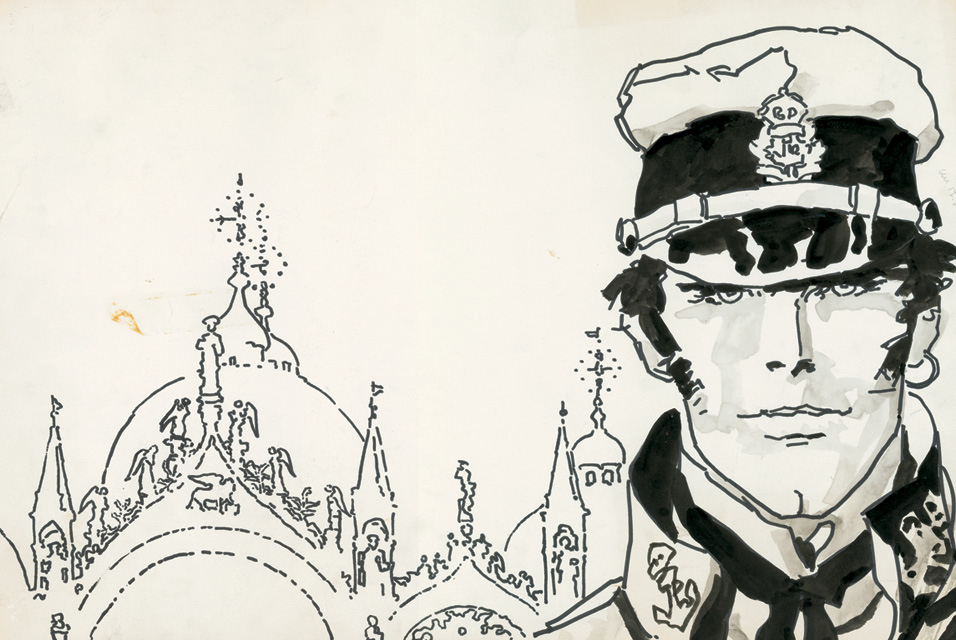
The Pinacothèque de Paris presents an exhibition of works by Hugo Pratt, on view through August 21, 2011. Thanks to this vast retrospective, the public can discover the breadth of the talent of the creator of Corto Maltese.
This exhibition shows over 150 watercolors, most of them little known by the broad public, as well as historical images, more specifically the whole of the 164 plates of the mythical Ballade de la mer salée.
Since the retrospective in the Grand Palais in 1986, it is the frst time that Paris has put on an exhibition devoted to the oeuvre of this exceptional artist, regarded as the inventor of the literary comic strip.
Hugo Pratt’s own life is a genuine novel, characterized by a genealogy combining various cultures. His life and his work were influenced by his literary culture – Robert Louis Stevenson, Joseph Conrad, Herman Melville, Jack London, Ernest Hemingway as well as Antoine de Saint- Exupéry, to whom he devoted an album at the end of his life : Le Dernier Vol – as well as by his travels to the four corners of the planet.
Born in 1927 in Rimini (Italy), he spent his childhood in Venice. His paternal grandfather, a draughtsman in military architecture, was a Lyonnais of British origin. His maternal grandfather was a Maronite Jew from Toledo, who lived in Venice. His maternal grandmother was a Jew whose parents had left Turkey to work in Murano, Italy. His mother, Evelina Genero, was fascinated by esotericism; her son inherited that interest in magic that we come across in the adventures of Corto Maltese. With such a rich ascendancy, it was quite normal that the draughtsman made of his most famous hero, the son of British sailor and of a gypsy, brought up in the barrio de la Juderia in Cordoba. When he was 14 years old, Hugo Pratt was enrolled by his father in the Italian colonial police in Abyssinia. There he came across the various armies whose uniforms, armories and colors shine forth in his series Les Scorpions du désert.
In 1943, when he went back to Italy after his father’s death, Hugo Pratt attended a military college and, thanks to his mastery of English, he became an interpreter in the allied forces until the end of the war. In April 1945, he returned to Venice to be present at the entry of the freedom fighters, in a Canadian tank, dressed as a Scotsman. « At the time, he said, Venice was a gigantic bordello, an improvised carnival! » He managed to enroll in the New-Zealand army after tattooing his face, like a Maori, with a fountain pen! Already, his legend was under way… Hugo Pratt therefore fought the war in all the camps, and wearing various uniforms…
Hugo Pratt officially became a comic strip draughtsman in 1945, when the first issue of L’As de pique, came out, a comics publication created with two friends. The «Venice Group » was then contacted by an important Argentinean publisher and, in 1949, Hugo Pratt settled in Buenos Aires. His Argentinean period that lasted all through the fifties was very prolific. He worked for the publisher Abril, for whom he drew Junglemen and several other series. The most striking came to light in 1953 with the character of Sergent Kirk. He started to write his own stories, the first among them being Ann de la jungle.
The year he spent in London between 1959 and 1960 was fundamental in Pratt’s career. In partnership with English screen writers, he wrote war stories for Fleetway Publications but above all, he became familiar with watercolor techniques by attending classes at the Royal Academy of Watercolour.
In 1962, following the downturn of the economical situation in Argentina, Hugo Pratt decided to return to Italy, even though he continued to travel.
During the following decade, Pratt’s work emphasized his passion for literature. After Wheeling (1962), his first masterpiece, he adapted Simbad le marin, Le Retour d’Ulysse, Sandokan, as well as his bedside book, Treasure Island by Robert Louis Stevenson. A voracious reader, Hugo Pratt’s eclecticism went from travel writers to the mythological tales of several civilizations, from William Shakespeare to James Joyce, from Jorge Luis Borges to John Reed or the Bible by way of Octavio Paz…
Even as he led a life worthy of a hero in a novel, like in Blaise Cendrars or Joseph Kessel, he never ceased to demonstrate via his work that he was the most erudite draughtsman of his time. That was probably why Umberto Eco declared: « When I want to relax, I read an essay by Engels, and if, on the other hand, I want to engage in something, I read Corto Maltese ».
Hugo Pratt’s love life was always eventful. In 1953, he married for the first time in Buenos Aires a young woman of Yugoslav origin with whom he had two children.
He divorced in Mexico in 1957 after meeting a ravishing German woman who became his assistant. Later on, he moved in with his new partner, of Belgian origin, whom he married in Venice in 1963 and with whom he had two more children. In 1965, during a trip to Brazil, Hugo Pratt discovered the existence of Tebocua, another son, he had had with an Indian called Xavantes. That same year, that man who loved women legally recognized other children: the young Victoriana Aureliana Gloriana dos Santos whom he had with a priestess in Macumba, as well as the four illegitimate children of the four sisters. That is how, in Salvador de Bahia, nowadays one can come across a Lincoln Pratt, a Wilson Pratt or a Washington Pratt…
In 1967, after a journey to the Caribbean, Hugo Pratt created La Ballade de la mer salée, which was the first appearance of Corto Maltese. It was a genuine revolution in the ninth art: never before had the art of the author and the art of the storyteller been united in that manner.
In April 1970, the millions of readers of Pif Gadget had the privilege of the first appearance in French of Corto Maltese.
The eighties were those of consecration, with over eight million albums sold. Having been made an honorary citizen of the city of Wheeling in Virginia (USA), he was made a Chevalier in the Ordre des Arts et des Lettres by Jack Lang.
In 1992, he went to the Samoa Islands to visit Robert Louis Stevenson’s grave.
After an expedition in Patagonia, he published Tango, a very realistic story about the white slave traffic in Argentina. Other adventures of Corto Maltese, La Fable de Venise or Les Helvétiques, were proofs of his taste for the fantastical. In between two journeys, he illustrated poems by Rudyard Kipling, erotic sonnets by Giorgio Baffo or the Lettres d’Afrique by Arthur Rimbaud. His trip to Easter Island inspired Mû, the last of Corto’s adventures.
In 1983, Hugo Pratt settled in Switzerland, in his house in Grandvaux on the lake in Lausanne, where he died on August 20, 1995.









